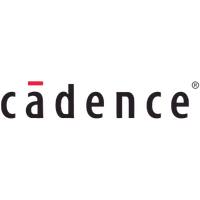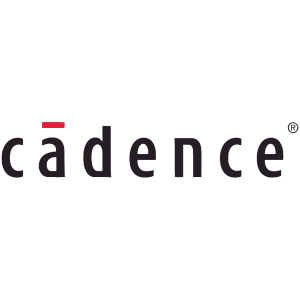
Cadence Design Systems Inc
NASDAQ:CDNS


| US |

|
Johnson & Johnson
NYSE:JNJ
|
Pharmaceuticals
|
| US |

|
Berkshire Hathaway Inc
NYSE:BRK.A
|
Financial Services
|
| US |

|
Bank of America Corp
NYSE:BAC
|
Banking
|
| US |

|
Mastercard Inc
NYSE:MA
|
Technology
|
| US |

|
UnitedHealth Group Inc
NYSE:UNH
|
Health Care
|
| US |

|
Exxon Mobil Corp
NYSE:XOM
|
Energy
|
| US |

|
Pfizer Inc
NYSE:PFE
|
Pharmaceuticals
|
| US |

|
Palantir Technologies Inc
NYSE:PLTR
|
Technology
|
| US |

|
Nike Inc
NYSE:NKE
|
Textiles, Apparel & Luxury Goods
|
| US |

|
Visa Inc
NYSE:V
|
Technology
|
| CN |

|
Alibaba Group Holding Ltd
NYSE:BABA
|
Retail
|
| US |

|
3M Co
NYSE:MMM
|
Industrial Conglomerates
|
| US |

|
JPMorgan Chase & Co
NYSE:JPM
|
Banking
|
| US |

|
Coca-Cola Co
NYSE:KO
|
Beverages
|
| US |

|
Walmart Inc
NYSE:WMT
|
Retail
|
| US |

|
Verizon Communications Inc
NYSE:VZ
|
Telecommunication
|
Utilize notes to systematically review your investment decisions. By reflecting on past outcomes, you can discern effective strategies and identify those that underperformed. This continuous feedback loop enables you to adapt and refine your approach, optimizing for future success.
Each note serves as a learning point, offering insights into your decision-making processes. Over time, you'll accumulate a personalized database of knowledge, enhancing your ability to make informed decisions quickly and effectively.
With a comprehensive record of your investment history at your fingertips, you can compare current opportunities against past experiences. This not only bolsters your confidence but also ensures that each decision is grounded in a well-documented rationale.
Do you really want to delete this note?
This action cannot be undone.

| 52 Week Range |
233.96
326.5
|
| Price Target |
|
We'll email you a reminder when the closing price reaches USD.
Choose the stock you wish to monitor with a price alert.

|
Johnson & Johnson
NYSE:JNJ
|
US |

|
Berkshire Hathaway Inc
NYSE:BRK.A
|
US |

|
Bank of America Corp
NYSE:BAC
|
US |

|
Mastercard Inc
NYSE:MA
|
US |

|
UnitedHealth Group Inc
NYSE:UNH
|
US |

|
Exxon Mobil Corp
NYSE:XOM
|
US |

|
Pfizer Inc
NYSE:PFE
|
US |

|
Palantir Technologies Inc
NYSE:PLTR
|
US |

|
Nike Inc
NYSE:NKE
|
US |

|
Visa Inc
NYSE:V
|
US |

|
Alibaba Group Holding Ltd
NYSE:BABA
|
CN |

|
3M Co
NYSE:MMM
|
US |

|
JPMorgan Chase & Co
NYSE:JPM
|
US |

|
Coca-Cola Co
NYSE:KO
|
US |

|
Walmart Inc
NYSE:WMT
|
US |

|
Verizon Communications Inc
NYSE:VZ
|
US |
This alert will be permanently deleted.
 Cadence Design Systems Inc
Cadence Design Systems Inc
Cadence Design Systems Inc




In the fiercely competitive realm of electronic design automation (EDA), Cadence Design Systems Inc. stands as a titan, orchestrating the seamless symphony of hardware and software development. Founded in 1988 through the merger of SDA Systems and ECAD, Inc., Cadence has steadily built a reputation for providing comprehensive design solutions that enable the creation of complex and innovative semiconductor products. With its headquarters nestled in San Jose, California, the company leverages its extensive suite of tools to aid engineers in the intricate art of designing integrated circuits and systems on chips. These tools streamline design processes and improve productivity, enabling clients to bring cutting-edge consumer electronics, telecommunications equipment, and other technology products to market more swiftly and efficiently.
Central to Cadence’s business model is not just software licensing but also its innovative subscription and services approach, which fosters enduring relationships with its clientele. Cadence's revenue streams predominantly flow from software, particularly through selling licenses for its cutting-edge design tools in perpetual, time-based, and subscription formats. In addition, the company provides specialized support and service offerings that enhance its software solutions, further embedding its tools into clients' workflows. By offering thoughtful and personalized support, Cadence ensures its tools evolve in tandem with each customer's needs. This unique combination of technological prowess and adaptable business strategy has allowed Cadence Design Systems to carve a powerful niche in the highly competitive world of electronic systems design.

In the fiercely competitive realm of electronic design automation (EDA), Cadence Design Systems Inc. stands as a titan, orchestrating the seamless symphony of hardware and software development. Founded in 1988 through the merger of SDA Systems and ECAD, Inc., Cadence has steadily built a reputation for providing comprehensive design solutions that enable the creation of complex and innovative semiconductor products. With its headquarters nestled in San Jose, California, the company leverages its extensive suite of tools to aid engineers in the intricate art of designing integrated circuits and systems on chips. These tools streamline design processes and improve productivity, enabling clients to bring cutting-edge consumer electronics, telecommunications equipment, and other technology products to market more swiftly and efficiently.
Central to Cadence’s business model is not just software licensing but also its innovative subscription and services approach, which fosters enduring relationships with its clientele. Cadence's revenue streams predominantly flow from software, particularly through selling licenses for its cutting-edge design tools in perpetual, time-based, and subscription formats. In addition, the company provides specialized support and service offerings that enhance its software solutions, further embedding its tools into clients' workflows. By offering thoughtful and personalized support, Cadence ensures its tools evolve in tandem with each customer's needs. This unique combination of technological prowess and adaptable business strategy has allowed Cadence Design Systems to carve a powerful niche in the highly competitive world of electronic systems design.
Earnings Calls
Management

Dr. Anirudh Devgan is a prominent figure in the field of electronic design automation (EDA), currently serving as the President and CEO of Cadence Design Systems, Inc., a leading company in computational software. He assumed the role of President in 2017 and became CEO in December 2021. Dr. Devgan's extensive knowledge and innovative contributions have significantly guided Cadence in expanding its technology offerings and maintaining its leadership position within the EDA industry. Prior to joining Cadence in 2012, Dr. Devgan amassed considerable experience in the industry through leadership roles at Magma Design Automation and IBM. His technical expertise encompasses a wide range of areas, including integrated circuit (IC) design, simulation, and verification. Dr. Devgan holds a Ph.D. in Electrical and Computer Engineering, and over the years, he has published numerous papers and holds several patents in EDA. His work emphasizes the importance of computational software tools in advancing modern electronics, contributing significantly to the development of cutting-edge technologies. Under his leadership, Cadence has strengthened its core EDA technologies while also expanding into adjacent fields such as computational fluid dynamics, AI-driven system design, and more. Dr. Devgan's strategic vision and emphasis on innovation continue to foster growth and transformation within Cadence, reflecting his status as a respected leader in the tech industry.

Prior to joining Cadence in 2012, Dr. Devgan amassed considerable experience in the industry through leadership roles at Magma Design Automation and IBM. His technical expertise encompasses a wide range of areas, including integrated circuit (IC) design, simulation, and verification.
Dr. Devgan holds a Ph.D. in Electrical and Computer Engineering, and over the years, he has published numerous papers and holds several patents in EDA. His work emphasizes the importance of computational software tools in advancing modern electronics, contributing significantly to the development of cutting-edge technologies.
Under his leadership, Cadence has strengthened its core EDA technologies while also expanding into adjacent fields such as computational fluid dynamics, AI-driven system design, and more. Dr. Devgan's strategic vision and emphasis on innovation continue to foster growth and transformation within Cadence, reflecting his status as a respected leader in the tech industry.

John M. Wall serves as Senior Vice President and Chief Financial Officer (CFO) at Cadence Design Systems, Inc. In his role, he oversees the company’s financial operations, including financial planning, reporting, accounting, tax, treasury, and investor relations. Wall has been instrumental in driving Cadence’s growth strategies, with a commitment to financial integrity and operational excellence. He joined Cadence in 1997 and has served in various leadership roles within the finance organization, including as Corporate Vice President of Finance and before becoming CFO. Wall’s deep industry knowledge and experience have contributed significantly to the company’s success in the semiconductor and electronics industries. His leadership is also characterized by his ability to foster innovation and growth, ensuring that Cadence maintains its competitive edge in a fast-evolving market. This has allowed the company to deliver strong financial performances while continuing to expand its influence in new technological advancements. John M. Wall's contributions are highly valued by Cadence Design Systems, where he combines strategic financial oversight with a forward-thinking vision to propel the company forward.

He joined Cadence in 1997 and has served in various leadership roles within the finance organization, including as Corporate Vice President of Finance and before becoming CFO. Wall’s deep industry knowledge and experience have contributed significantly to the company’s success in the semiconductor and electronics industries.
His leadership is also characterized by his ability to foster innovation and growth, ensuring that Cadence maintains its competitive edge in a fast-evolving market. This has allowed the company to deliver strong financial performances while continuing to expand its influence in new technological advancements.
John M. Wall's contributions are highly valued by Cadence Design Systems, where he combines strategic financial oversight with a forward-thinking vision to propel the company forward.
Aneel Zaman is a key executive at Cadence Design Systems, Inc., a leading company in electronic design automation and intelligent system design technologies. Serving as the Senior Vice President of Worldwide Field Operations, Zaman plays a crucial role in overseeing global sales and field engineering activities for the company. With his leadership, Cadence focuses on driving customer success and expanding market reach, effectively aligning with the company's strategic goals. Known for his deep industry knowledge and strategic acumen, Zaman has been significant in fostering relationships with key customers and partners worldwide, ensuring that Cadence delivers innovative solutions that align with evolving market demands. His expertise in sales strategy, customer engagement, and operational excellence has been instrumental in Cadence's continued growth and success in the highly competitive tech industry. Before his current role, Aneel Zaman held various positions at Cadence, where he significantly contributed to the company's trajectory and reputation as a leader in its field.
Known for his deep industry knowledge and strategic acumen, Zaman has been significant in fostering relationships with key customers and partners worldwide, ensuring that Cadence delivers innovative solutions that align with evolving market demands. His expertise in sales strategy, customer engagement, and operational excellence has been instrumental in Cadence's continued growth and success in the highly competitive tech industry. Before his current role, Aneel Zaman held various positions at Cadence, where he significantly contributed to the company's trajectory and reputation as a leader in its field.
Dr. Chin-Chi Teng is a notable figure in the field of technology, particularly known for his leadership role at Cadence Design Systems, Inc., where he has significantly contributed to the company’s growth and innovation in electronic design automation (EDA). Dr. Teng holds a Ph.D. and brings a wealth of expertise and experience to his role. At Cadence, Dr. Teng has been involved in driving advancements in design systems that facilitate the creation and development of complex electronic systems and semiconductors. His efforts have been instrumental in enhancing the capabilities of Cadence’s software solutions, which are widely used in the design and verification of integrated circuits and electronic systems. Dr. Teng is respected for his deep technical knowledge and his ability to lead teams towards achieving strategic objectives that meet the evolving needs of the technology industry. His work supports Cadence’s mission to enable electronic design innovation and deliver cutting-edge solutions to its clients. Dr. Teng's contributions have not only helped in maintaining Cadence's reputation as a leader in the EDA industry but also in pushing the boundaries of what is possible in electronic design and automation.
At Cadence, Dr. Teng has been involved in driving advancements in design systems that facilitate the creation and development of complex electronic systems and semiconductors. His efforts have been instrumental in enhancing the capabilities of Cadence’s software solutions, which are widely used in the design and verification of integrated circuits and electronic systems.
Dr. Teng is respected for his deep technical knowledge and his ability to lead teams towards achieving strategic objectives that meet the evolving needs of the technology industry. His work supports Cadence’s mission to enable electronic design innovation and deliver cutting-edge solutions to its clients. Dr. Teng's contributions have not only helped in maintaining Cadence's reputation as a leader in the EDA industry but also in pushing the boundaries of what is possible in electronic design and automation.

Dr. Paul Cunningham is a senior vice president and general manager at Cadence Design Systems, Inc., a prominent company in the electronic design automation (EDA) industry. He leads the company's System & Verification Group, focusing on developing and enhancing cutting-edge verification technologies. With a rich background in EDA and a deep understanding of complex verification challenges, Dr. Cunningham plays a crucial role in advancing Cadence's verification solutions to meet the evolving needs of semiconductor and system companies. His leadership is instrumental in driving innovation and maintaining Cadence's position as a leader in the field of electronic design. Dr. Cunningham holds a Ph.D. in Computer Science, which underpins his technical expertise and strategic vision in the industry.

James Haddad is an executive at Cadence Design Systems, Inc., a leading company in electronic design automation and engineering services. As an experienced leader within the company, Haddad plays a significant role in driving the company's strategic initiatives, particularly in the areas of software development and digital transformation. Cadence provides cutting-edge solutions for designing complex integrated circuits, and Haddad's expertise contributes to advancing the company's mission to innovate in the electronics industry. His work encompasses overseeing projects that involve collaborating with technology teams to enhance product offerings, streamline operations, and maintain Cadence's competitive edge in the marketplace.
Sukanta Tarak Ray is an executive officer at Cadence Design Systems, Inc. He holds the position of Corporate Vice President and Global Head of Customer Engineering and Support. In this role, Mr. Ray oversees the engineering support functions globally, ensuring that customers receive the technical support and guidance needed to successfully use Cadence's software solutions. Mr. Ray has been with Cadence for many years, contributing his expertise in electronics design automation (EDA) to the company. His extensive experience in the semiconductor and EDA industries equips him to understand the complex challenges customers face and to provide strategic oversight in addressing these challenges. Throughout his career, Mr. Ray has been recognized for his leadership capabilities and his commitment to fostering innovation in engineering support services. His work at Cadence Design Systems has been pivotal in enhancing the company's relationship with its clients by ensuring high-quality service and support.
Mr. Ray has been with Cadence for many years, contributing his expertise in electronics design automation (EDA) to the company. His extensive experience in the semiconductor and EDA industries equips him to understand the complex challenges customers face and to provide strategic oversight in addressing these challenges.
Throughout his career, Mr. Ray has been recognized for his leadership capabilities and his commitment to fostering innovation in engineering support services. His work at Cadence Design Systems has been pivotal in enhancing the company's relationship with its clients by ensuring high-quality service and support.
As of the most recent information, Richard Gu is linked with Cadence Design Systems, Inc., a major player in electronic design automation. Richard Gu holds the role of Corporate Vice President of Enterprise Risk Management, Audit, and Controls. In this capacity, he is tasked with managing and overseeing the company’s enterprise risk management framework, internal auditing processes, and control mechanisms to ensure efficient governance and risk mitigation. He joined Cadence in 2008 and has played a significant role in ensuring the company adheres to its compliance standards and operational efficiency. He is renowned for his strong analytical skills and strategic insights, which have been crucial in driving the company’s successful risk management initiatives. Richard Gu's educational background includes degrees in business and finance, which have equipped him with the expertise required for his roles in enterprise risk and auditing.
He joined Cadence in 2008 and has played a significant role in ensuring the company adheres to its compliance standards and operational efficiency. He is renowned for his strong analytical skills and strategic insights, which have been crucial in driving the company’s successful risk management initiatives. Richard Gu's educational background includes degrees in business and finance, which have equipped him with the expertise required for his roles in enterprise risk and auditing.

Karna Nisewaner, J.D., serves as an executive at Cadence Design Systems, Inc., holding the position of Senior Vice President, General Counsel, and Corporate Secretary. She plays a vital role in overseeing the company's legal affairs and providing strategic guidance on legal matters. Her responsibilities include managing corporate governance, intellectual property, compliance, and regulatory affairs. Ms. Nisewaner's background in law is robust, with a Juris Doctor degree that underpins her expertise in legal and corporate governance issues. Before her tenure at Cadence, she gained significant experience working in various legal capacities, which has equipped her with the insights and skills necessary to navigate complex legal challenges in the tech industry. Throughout her career, Ms. Nisewaner has been recognized for her leadership and her ability to align legal strategy with business goals, making significant contributions to Cadence Design Systems' growth and operation. Her role is crucial in ensuring that the company adheres to legal standards while pursuing its strategic objectives.

Ms. Nisewaner's background in law is robust, with a Juris Doctor degree that underpins her expertise in legal and corporate governance issues. Before her tenure at Cadence, she gained significant experience working in various legal capacities, which has equipped her with the insights and skills necessary to navigate complex legal challenges in the tech industry.
Throughout her career, Ms. Nisewaner has been recognized for her leadership and her ability to align legal strategy with business goals, making significant contributions to Cadence Design Systems' growth and operation. Her role is crucial in ensuring that the company adheres to legal standards while pursuing its strategic objectives.































 You don't have any saved screeners yet
You don't have any saved screeners yet
